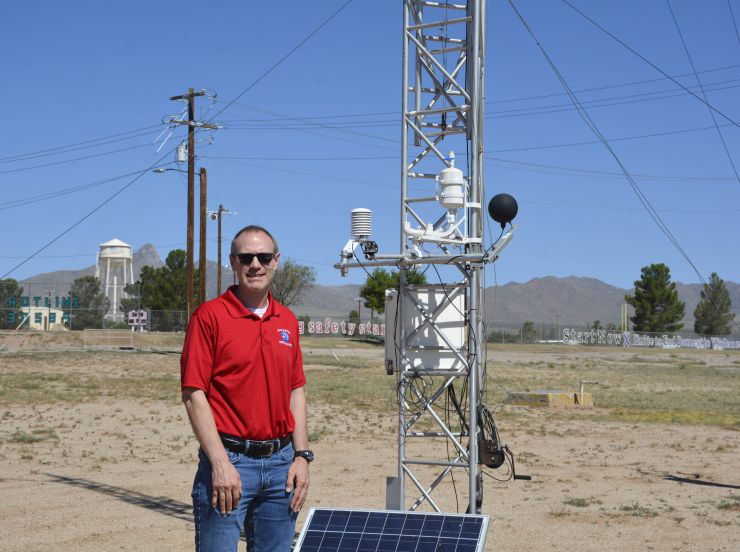
Blaine Thomas, a Meteorologist with the Meteorology Branch at White Sands Missile Range, stands in front of a Surface Atmospheric Measurement System or SAMS towers. This is one of about 40 that are located across the range. A general set up on a SAMS records the temperature, the humidity, air pressure, wind, and solar radiation. A couple of sites on post added additional instruments to measure the components of the WBGT to include a black globe, which measures the intensity of the solar radiation on a person, and an instrument with a water reservoir which measures a variable called the natural wet bulb temperature.
WSMR Meteorologist collaborates on WBGT paper
Blaine Thomas, a Meteorologist with the Meteorology Branch at White Sands Missile Range, has co-authored a paper that deals with the Wet Bulb Globe Temperature.
The paper, entitled "Heat Stress Metrics, Trends, and Extremes in the Southeastern United States" is soon to be published in the Journal of Applied Meteorology and Climatology from the American Meteorological Society.
“My contribution to the paper was supplying the co-authors with measured WBGT data from three locations in the southeastern US (Redstone Arsenal, Eglin Air Force Base, and the North Carolina ECONet) that were part of a Range Commanders Council Meteorology Group WBGT data collection campaign in 2021 involving 13 participates across the United States for which I was the group task lead,” Thomas said. “These data were used to assess different estimation algorithms that were then applied to the analysis of trends and extremes in WBGT at 39 locations across the southeastern US using observed weather data back to 1950.”
The Wet Bulb Globe Temperature is a measure of the heat stress in direct sunlight, which takes into account: temperature, humidity, wind speed, sun angle and cloud cover (solar radiation). This differs from the heat index, which takes into consideration temperature and humidity and is calculated for shady areas.
WBGT tells us how hot it is based on the (1) temperature, (2) humidity, (3) wind speed, and (4) sunlight. It was developed by the US military in the 1950s to prevent heat-related deaths in training camps. Today it is used in some workplaces and for some sports, such as high school football in a few US states.
Thomas collaborated with two co-authors Dr. Shawn Milrad from Embry-Riddle Aeronautical University and Dr. Kathie Dello from the North Carolina State Climate Office.
He said they are looking at developing an index based off the WBGT that would provide a more simplified message to the general public to let them know just how high the heat stress is on a given day.
Thomas is also responsible for a white paper he wrote for the Range Commanders Council entitled "Finding Improvements in the Measurement and Estimation of Wet-bulb Globe Temperature".
“This paper covers many of the intricacies and challenges of measuring the WBGT and provides an initial assessment of data collected by the 13 campaign participants,” Thomas said. “These data will serve as the basis for the second white paper I am currently writing that will assess WBGT estimation algorithms currently in the scientific literature that use standard meteorological data and will provide improved estimation algorithms based on the campaign data. That paper will hopefully be available to the public in early 2025.”
Speaking about the weather, Thomas said these last two summers have definitely been hotter than previous years.
“These last two summers have been in the top hottest summers on record. The summer of 2023 was the hottest on record. This year has been close,” Thomas said. “We have seen increases in the peak WBGT values here at WSMR compared to previous years. So, it is putting our workforce more at risk in the afternoon hours if you they are not taking the proper precautions.”
Some of the things employees can do to help are drink water, take breaks and stay in the shade.
“We measure this variable in the open air where you would be exposed to sunlight so even just a little bit of shade helps dramatically.”
These tips are especially helpful during the hottest hours of the day between 10 a.m. and 3 p.m.
Thomas said cloud cover does help because it provides some shade along with the winds picking up.
The work Thomas is doing is still ongoing. He said the paper he co-authored is the first of a series of three papers that are coming out.
Thomas is a native of Minnesota. He received an associate’s degree from Bethany Lutheran College followed by a bachelor’s degree in meteorology from St. Cloud State University. He also got a master’s degree in Wisconsin.
He started his first job at WSMR in 2005, and has been here since, except for the year he took off in 2021 to take another position in Minnesota. He said that job was not a good fit for him, so he came back to work for WSMR in Aug. 2022.
“I loved it down here in a lot of respects to include the job and the climate. I was fortunate to be able to come back to the same position.”
Miriam Rodriguez
WSMR Public Affairs




